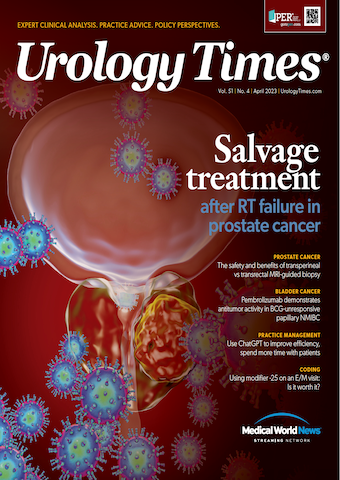Publication
Article
Urology Times Journal
What is your reaction to the American Cancer Society’s statistics showing a rise in advanced prostate cancer?
Author(s):
"The pendulum is swinging back. It’s all about provider education, hammering home the point that we have to do appropriate screening," says urologist Ryan Hankins, MD.
“It’s probably due to the [US Preventive Services Task Force] recommendations and a lag effect. When the task force changed its position on PSA [prostate-specific antigen] screening, we knew we’d see a return of the prostate cancer that existed 20 to 30 years ago, prior to the advent of screening where patients would present with either local invasion or metastatic disease. That lag effect ultimately caught up with us. We’ve been seeing the shift to high-risk disease for probably the past 8 years.
To reverse that trend, we need to educate our primary care providers and internists on implementing PSA screenings on the front line more commonly, and on managing those populations with active surveillance and stratification of low-risk, intermediate-risk, and high-risk disease. Making primary care physicians more aware of what PSA screening should actually be [can] help detect localized prostate cancer.
There is a fear [that] PSA screening leads to unnecessary testing; that’s why education is needed. There’s a sweet spot there. Right now, upward of 25% to 30% of our patients now present with high-risk prostate cancer—that’s Gleason 8, 9, 10—[which is] much higher than a decade ago, when that number was less than 10% to 15%.
It’s going to take data like this study showing the increase in prostate cancer to convince doctors to start screening again, then managing low-risk cancers appropriately so there isn’t that increase in unnecessary testing.”
Benjamin Lee, MD
Tucson, Arizona
Ryan Hankins, MD

“That was the biggest concern urologists had when the original task force recommendations came out. Urologists said that would happen. We’ve always known that prostate cancer is relatively slow growing compared [with] other cancers. We had to wait to see the outcomes of those recommendations released 10 years ago.
A generation of primary care doctors stopped screening. Very few [individuals] would disagree with the notion [that] we weren’t using PSA appropriately. Anybody who walked in the door got a PSA. Unfortunately, that led to overdiagnosis and overtreatment of prostate cancer. [Patients] were treated for prostate cancer that was never going to kill them. We didn’t know at the time that patients with low-risk prostate cancer should not be treated. A lot of [patients] were treated who didn’t need it. Patient anxiety over their cancer is not a reason to get treated.
Unfortunately, less screening happens at the primary care level, and most men don’t see a urologist unless they have a urological issue. The primary care level is where we need more education and screening.
[American Urological Association] guidelines recommend screening men of average risk between the ages of 55 and 70. I’ve seen men younger than 55 with prostate cancer, so I tend to get a baseline PSA at 45 and, as long as it’s normal, have them come back for another at age 50. I’ll generally catch those who would eventually be diagnosed before they hit 55. The [patients] we’re missing are the ones who don’t see a urologist but see a primary care doctor who isn’t checking PSA.
The pendulum is swinging back. It’s all about provider education, hammering home the point that we have to do appropriate screening.
The biggest problem was that those task force recommendations were based on a deeply flawed study that has pretty much been debunked at this point.”
Ryan Hankins, MD
Washington, DC
“When the guidelines came out questioning whether PSA testing should be done, the recommendation was to have a discussion with your patient [about] whether he wanted to be screened for prostate cancer.
Unfortunately, a lot of primary care physicians do not have those conversations with patients. In fairness, they probably don’t have the time. In my opinion, those recommendations were misconstrued. Primary care doctors just stopped doing prostate exams.
We’ve got patients coming in who haven’t been examined and haven’t had a PSA. I don’t think that was the intention of the guidelines. The intention was that doctors should share with their patients the advantages and disadvantages of PSA testing, then the patient and the doctor would decide. That didn’t mean patients should not be examined.
When patients come to me, I have that discussion with them, then let them decide. Ideally, the primary care doctor would do that, but realistically, that doesn’t happen.
Realistically, primary care doctors probably don’t have time, nor do some of them have the expertise to have that conversation, [which is] unfortunate.
Someone whose life expectancy is 5 years or less, and doctors get PSAs and see patients whose prostate cancer is never going to kill them, but they’ve got an elevated PSA. Then you have to have a different discussion with them. I don’t know that that’s going to happen.”
Michael Kane, MD
Hanover, Pennsylvania

































